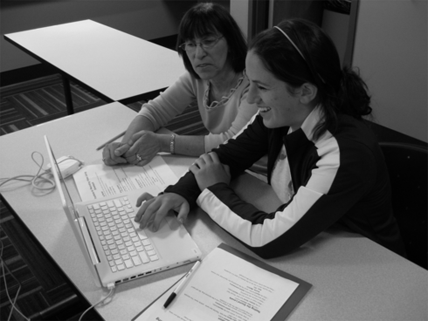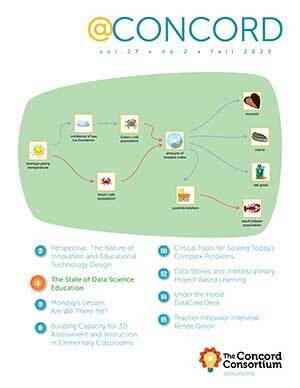The Deeply Digital Texts Initiative
The Concord Consortium’s initiative starts with seven new projects.
The latest educational trend is to jettison textbooks in a quick switch to alternative technology. A prep school in Massachusetts has proudly announced the dismantling of their entire school library in favor of digital books. Parents are searching for alternatives to buying college texts, the cost of which often tops $1,000 per year. Amazon is hoping to capture part of the $5.5 billion textbook market with their Kindle reader.

At the Concord Consortium, we welcome the interest in technology, but take a different view. Digital texts require a huge, but exciting investment in technology. However, there is a real danger that they could fall into the trap of simply delivering the same old education. Digital texts should instead take full advantage of the new medium to exploit five unique advantages offered by networked computers:
Interactivity Technology opens up powerful ways of learning by guided exploration of real and virtual worlds. Instead of being told, students can be guided to discover for themselves how the world works. Compelling and personal immersive environments offer enticing ways to do this.
Assessment Interactive materials provide opportunities for new kinds of assessment, including monitoring the performance of individuals and groups of students. Student performance data can be streamed to teachers who can use the results to match each student’s prior knowledge and skills.
Currency For many reasons, textbooks resist change. Often their content is out of date as soon as they are released. Some states even require them to remain unchanged for at least a decade. Technology-based materials can be updated and connected to current research and thinking.
Plasticity Textbooks are designed for average students and they often fail to engage most learners. Electronic media can be customized and adapted to meet different students’ needs.
Community Texts are part of a top-down authoritarian model of education, where a few experts dictate what the masses must learn. Electronic media development can take place within an online community of educators and students, provided that design criteria and reviews are in place to maintain quality.
We envision courses that rely on community-generated and customized materials based on guided inquiry. Digital resources of the future will generate formative feedback to teachers and students and support differentiated instruction. The materials will be constantly improving because the community of subject and pedagogy experts will integrate current research results and tools.
Unfortunately, we are not there yet. Some fundamental questions have yet to be answered about how students learn with highly interactive materials and how to take full advantage of the features of digital texts. Furthermore, innovative materials are needed to explore new ways of using technology. More topics need to be covered so that fully electronic courses can be developed and evaluated.
The Concord Consortium is dedicated to providing the innovations and answers, so that courses that take better advantage of technology can be created, refined, and studied. To hasten the day when this is possible, we have just launched a new “Deeply Digital Texts Initiative.” This initiative consists of seven new projects that each addresses one piece of the puzzle.
New strategies
Two of our new projects explore new applications of software. The first, “SmartGraphs,” is based on intelligent software that can recognize important features in graphs. It has implications for any teaching that relies on graphs. SmartGraphs “know” about themselves and students’ interactions with them. By providing scaffolding tailored to each student’s interactions with the graph, SmartGraphs help students learn about graphs and support them to analyze graphs in various contexts. Pennsylvania’s Classrooms for the Future program is a partner in this project. It provides a unique opportunity to test SmartGraphs, since it has deployed over 140,000 laptops in classrooms serving more than a half-million high school students. This allows us to determine whether the software intelligence can be harnessed to improve student graph skills acquisition and to improve the assessment of these skills.
A second project explores applications of advanced computational models to simulate complex situations involving fluid flow. We use the same methods used in current research to model everything from global climate patterns and ocean currents to blood flow. This project examines the fundamental question of whether pre-college students can master such complex systems and understand the relationship between a 3D model and physical models. The project focuses on designing and building an energy-efficient house as both a virtual model and a fully instrumented physical one. In partnership with Tufts, Purdue, and Hofstra universities as well as the Museum of Science in Boston, this project is developing new curriculum materials and conducting a controlled study to determine whether simulations and hands-on projects are mutually beneficial. We are especially excited about this project’s ability to promote awareness of sustainability issues among high school students.
Stronger proofs
There is broad belief that guided student exploration of virtual systems holds great value, enabling experiments with systems (entire galaxies down to individual atoms) and across time scales (femtoseconds to millennia). But more proofs are urgently needed that might convince cash-strapped schools to invest in these approaches. Two new projects are designed to provide these proofs in areas that have broad implications.
The first of these undertakes a longitudinal study of student retention and application to supplement our ongoing Science of Atoms and Molecules project. This project uses computer models of atoms and molecules to clarify molecular explanations throughout secondary science courses. The research focuses on retention across grades, looking at whether this emphasis on the atomic scale in chemistry can help biology students a year later. This study provides critical data about whether students can transfer important concepts across years, a vital look at how technology-enhanced curriculum used over time can support the development of deep conceptual understanding.
A second study explores how curriculum and assessment based on dynamic, interactive visualizations of complex phenomena can ensure that all students learn significant science content. Educational researchers have raised troubling questions about the value of visualizations. They seem to indicate that sequences of drawings are more valuable for students. The VISUAL project will clarify when and how to use dynamic visualizations, taking into account factors such as student prior knowledge, the amount of interaction, and the clarity of the model itself. This project continues a longstanding collaboration between the Concord Consortium and Marcia Linn’s research group at the University of California, Berkeley, and carries on the work of our joint TELS Center.
Linking research to classrooms
Two new projects explore the ability of electronic media to link classrooms with areas of current science research. High-Adventure Science injects contemporary earth and space science into the classroom, engaging students in thinking about important unanswered questions that scientists around the world are actively exploring. For example, one topic is so-called “dark matter” discovered by Dr. Vera Rubin of the Carnegie Institution for Science in Washington, D.C. Students use models to discover why Rubin found it necessary to propose dark matter to explain data about galaxy rotation speeds. This project explores whether this kind of new content can motivate students and result in learning that is valued by schools.
The Geniverse project provides a different way to link students to research. In this project students learn firsthand how science knowledge develops in the rapidly changing fields of bioinformatics and DNA science by engaging in collaborative, simulated experiments to solve open-ended problems. Students learn about key experimental methods and the core biological concepts behind them, and then publish short summaries of their results and debate the findings and procedures of others, thus participating directly in the process of scientific investigation. The project studies whether and under what conditions this mix of scientific process, current research, and collaboration can accelerate student learning and motivation.
Scaling up and creating a community of practice
In order to study the idea that texts developed by experts can be replaced by materials generated by collaborating educators, we need to create a community that is large enough to be self-sustaining. Our new ITSI Scale-Up project represents a national expansion of prior work that can provide the required testbed. This five-year project provides research-based science materials directly to 264 teachers and 10,000 students in four states in its initial phase. The project has the capacity to reach another 1,500 teachers and 50,000 students nationwide and become self-sustaining in a dissemination phase. The central innovation of this work is that teachers learn new content and approaches by revising and sharing computer-based materials.
With these new endeavors, as well as our ongoing projects, the Concord Consortium is working to help define the future of educational technology. By creating new technologies, researching their effectiveness and developing and supporting exciting technology-enhanced curricula, we are demonstrating new ways for technology to support teaching and learning. By working on many aspects of the problem, these projects shape the development of the coming generation of digital texts, allowing them to integrate deeply and effectively with the best that technology has to offer and to support teachers and students far into the future.
